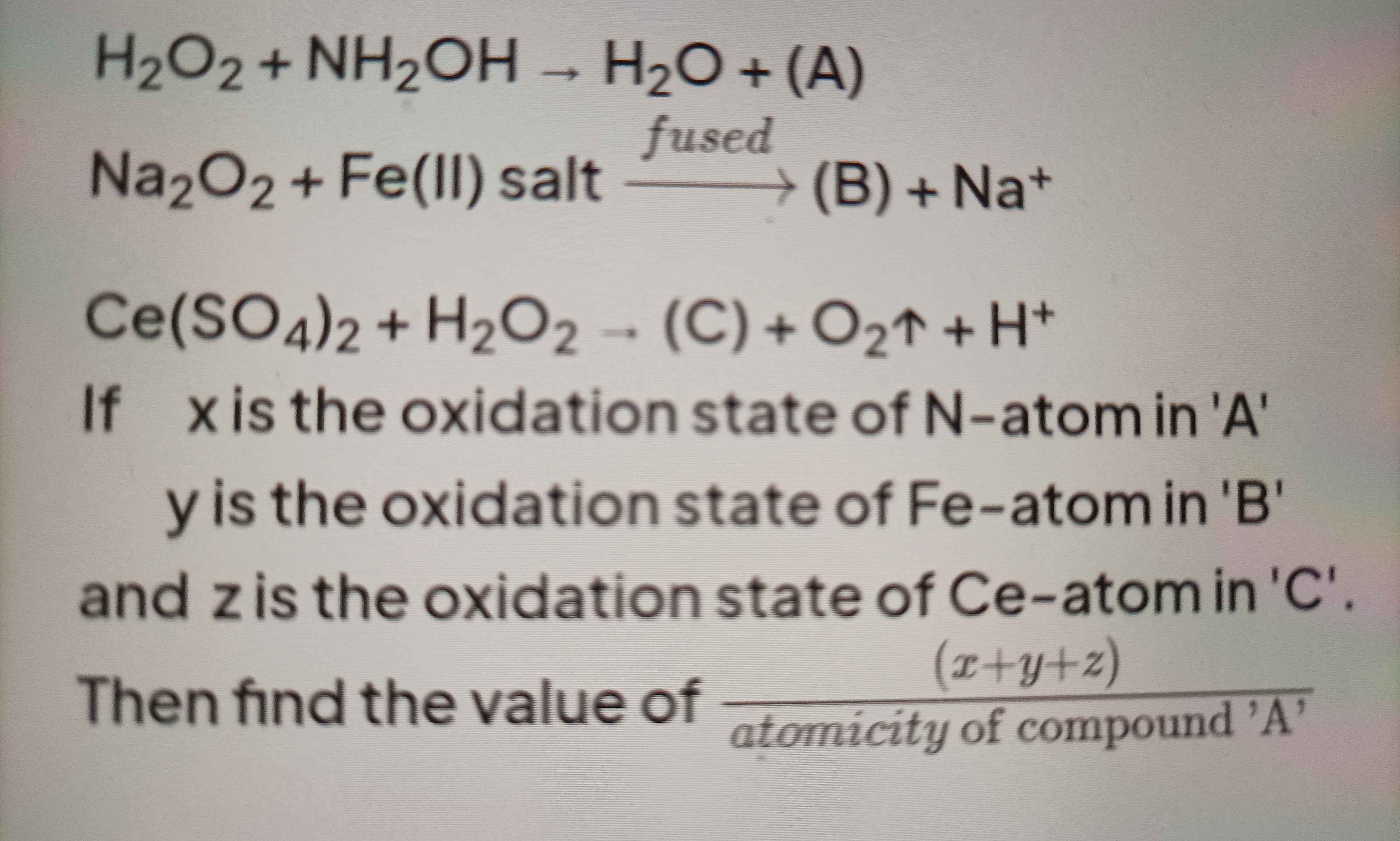Question
Question: H2O2 + NH2OH → H2O + (A) Na2O2 + Fe(II) salt $\xrightarrow{fused}$ (B) + Na+ Ce(SO4)2 + H2O2 → (C) +...
H2O2 + NH2OH → H2O + (A) Na2O2 + Fe(II) salt fused (B) + Na+ Ce(SO4)2 + H2O2 → (C) + O2↑ + H+ If x is the oxidation state of N-atom in 'A' y is the oxidation state of Fe-atom in 'B' and z is the oxidation state of Ce-atom in 'C'. Then find the value of atomicity of compound ′A′(x+y+z)

The value is 3.
Solution
Solving the question involves identifying the products of the given chemical reactions, determining the oxidation states of specific atoms in these products, and then performing a calculation based on these values and the atomicity of one of the products.
Reaction 1: H₂O₂ + NH₂OH → H₂O + (A)
This is a redox reaction where hydrogen peroxide (H₂O₂, oxygen in oxidation state -1) acts as an oxidizing agent, oxidizing hydroxylamine (NH₂OH, nitrogen in oxidation state -1). Hydroxylamine is oxidized to nitrogen gas (N₂).
H₂O₂ + 2NH₂OH → N₂ + 4H₂O
So, the compound (A) is N₂. The oxidation state of the N-atom in N₂ is 0. Thus, x = 0. The atomicity of compound 'A' (N₂) is 2 (since it's a diatomic molecule).
Reaction 2: Na₂O₂ + Fe(II) salt fused (B) + Na⁺
Sodium peroxide (Na₂O₂, oxygen in oxidation state -1) is a strong oxidizing agent, especially when fused. It reacts with Fe(II) compounds (iron in oxidation state +2) to oxidize iron to its highest stable oxidation state, which is +3. In the presence of sodium ions and oxide ions (from the reduced peroxide), iron(III) oxide (Fe₂O₃) is formed.
For example, using FeSO₄:
Na₂O₂ + FeSO₄ fused Fe₂O₃ + Na₂SO₄
(Balanced equation is more complex, but the key product containing Fe(III) is Fe₂O₃)
So, the compound (B) is Fe₂O₃. The oxidation state of the Fe-atom in Fe₂O₃ is +3 (2 * (+3) + 3 * (-2) = 0). Thus, y = +3.
Reaction 3: Ce(SO₄)₂ + H₂O₂ → (C) + O₂↑ + H⁺
Cerium(IV) sulfate (Ce(SO₄)₂, cerium in oxidation state +4) is a strong oxidizing agent. Hydrogen peroxide (H₂O₂, oxygen in oxidation state -1) acts as a reducing agent in the presence of strong oxidizers, getting oxidized to oxygen gas (O₂, oxygen in oxidation state 0). Cerium(IV) is reduced to cerium(III) (oxidation state +3).
2Ce⁴⁺ + H₂O₂ → 2Ce³⁺ + O₂ + 2H⁺
In solution with sulfate ions, the cerium(III) will exist as Ce³⁺ ions or form cerium(III) sulfate (Ce₂(SO₄)₃). The product (C) contains Ce(III). The oxidation state of the Ce-atom in (C) (which contains Ce³⁺) is +3. Thus, z = +3.
Now we have the values: x = 0 (oxidation state of N in A = N₂) y = +3 (oxidation state of Fe in B = Fe₂O₃) z = +3 (oxidation state of Ce in C = Ce(III)) Atomicity of compound 'A' (N₂) = 2.
We need to find the value of atomicity of compound ′A′(x+y+z). Value = 2(0+3+3)=26=3.
